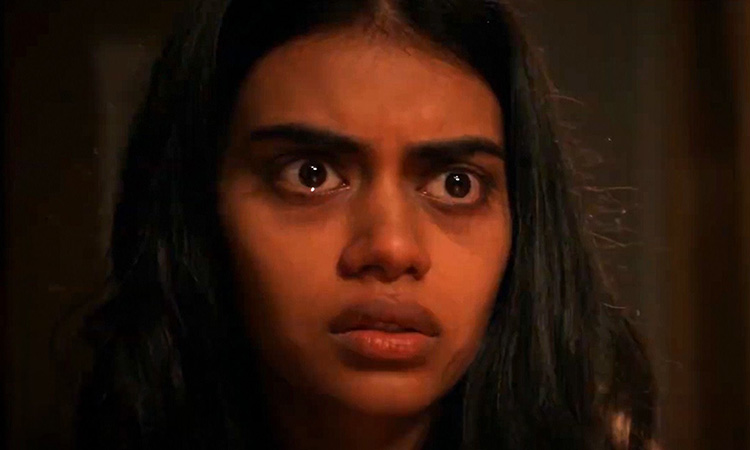“Talk to me,” says Poorna (Neeru Bajwa) to her teen daughter Samidha (Megan Suri) as they sit across the table from each other some way into It Lives Inside.
Although writer/director Bishal Dutta almost certainly neither would nor could have been aware of this during the production of his debut feature, Poorna’s words now resonate with the title of Danny and Michael Philippou’s Talk To Me (2022), where the phrase is used to open a gateway between the living and the dead. In Dutta’s film too, the phrase bridges a gulf, albeit one more cultural than spiritual, as it is the first (and almost the only) time we hear Poorna speak in English, rather than in her native Hindi, to Samidha. This pair, though, communicating at last, are about to join forces and, as in the Philippous’ film, willingly to invite in something supernatural and malevolent.
Bilingual Samidha is trapped between two cultures. Desperate, like so many adolescents, to fit in, she has turned her back on her Indian heritage in the suburban American community of Wooderson Grove where she lives with her dad Inesh (Vik Sahay) and Poorna.
Now going by an Americanised shortening of her name, insisting on speaking – even with her parents – only in English, and filtering the flesh tones of her online selfies towards the paler end of the spectrum, ‘Sam’ is trying to forge a new identity for herself, and to conform to her peers – a metamorphosis that seems in keeping with a high school whose basketball team is ominously called the ‘Werewolves’. Her best friend Kitty (Beatrice Kitsos) is white, her love interest Russ (Gage Marsh) is white, while she has made a conscious decision to sever ties with Tamira (Mohana Krishnan), her childhood friend and the only other Indian girl in the school.
Since then, Tamira has gone off the rails, becoming an isolated, unwashed recluse with messy hair, manic-panicked eyes and a dirty glass jar that she carries everywhere with her. Everyone has noticed Tamira’s decline, including African-American teacher Joyce (Betty Gabriel) who looks out for the only two women of colour in her class.
Samidha, though, is just embarrassed to be seen with her old friend. When the obviously distraught Tamira appeals to her for help, holding out the jar with the words, “There’s a monster in here. It’s all in the stories, the ones we heard growing up, they’re true, they’re all true”, Samidha slaps away the jar. This gesture, a rejection of the identity and background that she shares with Tamira and a violent expression of her deep-seated shame and guilt, causes the jar to shatter, unleashing the evil creature within, a Pishacha of Hindu myth. As everyone dear to her comes under threat from this vicious predator, Samidha must reinternalise her roots if she is to have any hope of defeating – or at least of containing – the creature that threatens to devour her.
“It’s like everything I wanted outside of me is inside of me and I can’t get it out,” Samidha tells Joyce, in language that might equally describe a teenager’s confused, frustrated notion of shifting selfhood, or a soul-eating demon that takes possession of its victim.
This ambiguity is the trick that It Lives Inside constantly plays. For as readily as Samidha changes from her traditional Hindu ceremonial dress to casual American apparel, the film switches between, on the one hand, the tropes of other ‘creeping curse’ films – the haunted family home of Takashi Shimizu’s Ju-on: The Grudge movies, the literal hair-raising of David Robert Mitchell’s It Follows (2014) and the ravenous entity of Scott Cooper’s Antlers (2021) – and on the other, its own subtextual themes of cross-cultural identity, assimilation and absorption.
Here Samidha’s own alienated adolescence is the horror, in a story where heroine and hybrid monster, though caught together in constant conflict, prove to be one and the same, and must reach a mutual accommodation – which starts with Samidha talking to her mother again…
It Lives Inside had its Quebec première at Fantasia 2023
